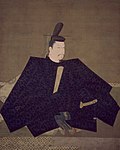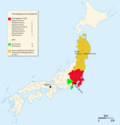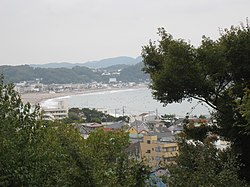Kamakura, Kanagawa
Kamakura (鎌倉市, Kamakura-shi) is a city in Kanagawa, Japan. It is about 50 kilometres (31 mi) south of Tokyo.[1] It was the functioning capital of Japan during the Kamakura period (1203-1333).[2]
| Kamakura | |||||
|---|---|---|---|---|---|
| Japanese name | |||||
| Kanji | 鎌倉市 | ||||
| Hiragana | かまくらし | ||||
| |||||
In 1250, Kamakura was the 4th largest city in the world with 200,000 people.[3] The other two large cities in Japan at this time were Kyoto and Nara.[4]
Kamakura was made a municipality on November 3, 1939.
Today, Kamakura is famous as an upper-class area for people to live. This is because of the history and because it is close to the mountains and the sea.
History
- 1192 (Kenkyū 3, 12th day of the 7th month): Kamakura Shogunate founded by Minamoto no Yoritomo[5]
- 1293 (Einin 1, 4th month): A severe earthquake; fatalities in Kamakura were estimated to be 10,000 people.[7]
Tourism
Kamakura has many Buddhist temples. The huge outdoor bronze statue of Buddha at Kamakura is world famous.[10]

The city has many Shinto shrines, including
Tsurugaoka Hachimangu Shrine is one of the three major Hachimangu located in Kamakura. It is the most popular spot in Kamakura, especially, Yabusame in September is very famous. Tsurugaoka Hachimangu was built in 1063 and became the capital and center of Kamakura Government established by Minamoto no Yoritomo. Turugaoka Hachiman-gu has many beautiful maple and ginkgo trees. In autumn, the vew at this shrine is nice.[11] In June, hydrangeas grow. Many temples have beautiful gardens of hydrangeas. The Hase temple is the most well-known of these temples.[12]
Sister cities
Kamakura has international sister cities.
Kamakura, Kanagawa Media
Portrait traditionally believed to be of Minamoto no Yoritomo, but now believed to be of Ashikaga Tadayoshi
The stele on the spot where Yoritomo's Ōkura Bakufu used to stand
The Hōjō family crest, ubiquitous in Kamakura
This field is the former site of Tōshō-ji, the Hōjō family temple. In 1333, the Hōjō clan committed mass suicide here.
A 1685 illustration from the Shinpen Kamakurashi of the lot where the kantō kubō's mansion once stood. It was left empty in the hope that he may one day return.
View over Kamakura's Sagami Bay coast from Hase-dera (Kamakura)
Tsurugaoka Hachiman-gū and the dankazura during the Edo period
References
- ↑ 1.0 1.1 1.2 "Kamakura, Kanagawa city web page". Archived from the original on 2008-04-02. Retrieved 2010-03-28.
- ↑ Hall. John Whitney. (1991). Japan: From Prehistory to Modern Times, pp. 86, 114.
- ↑ Cities, Empires and Global State Formation, Institute for Research on World-Systems
- ↑ Hall, p. 123.
- ↑ Hall, p. 359; Kitagawa et al. (1975). The Tale of the Heike, p. 788.
- ↑ Kate Tsubata (May 25, 2008). The Great Buddha at Kamakura. The Washington Times. http://www.washingtontimes.com/weblogs/donne-travels-washington-times/2008/may/25/the-great-buddha-at-kamakura/.
- ↑ Titsingh, Isaac. (1834). Annales des empereurs du japon, p. 273.
- ↑ Hammer, Joshua. (2006). Yokohama Burning: the Deadly 1923 Earthquake and Fire that Helped Forge the Path to World War II, p. 278.
- ↑ Hammer, pp. 115-116.
- ↑ "Kotoku-in" ("The Great Buddha"), Kamakura Today. Archived 2012-06-07 at the Wayback Machine 2002.
- ↑ Yahoo Kouyou[dead link]
- ↑ "Today". Archived from the original on 2013-07-12. Retrieved 2013-11-26.
Other websites
| Wikimedia Commons has media related to Lua error in Module:Commons_link at line 62: attempt to index field 'wikibase' (a nil value).. |
- Rudyard Kipling poem, "The Buddha at Kamakura", 1892
- Official web site Archived 2009-12-08 at the Wayback Machine
- Kamakura's Daibutsu Archived 2007-09-27 at the Wayback Machine
- Kamakura's History - Chronological table Archived 2009-05-17 at the Wayback Machine
 Kamakura travel guide from Wikivoyage
Kamakura travel guide from Wikivoyage Geographic data related to Kamakura, Kanagawa at OpenStreetMap
Geographic data related to Kamakura, Kanagawa at OpenStreetMap












